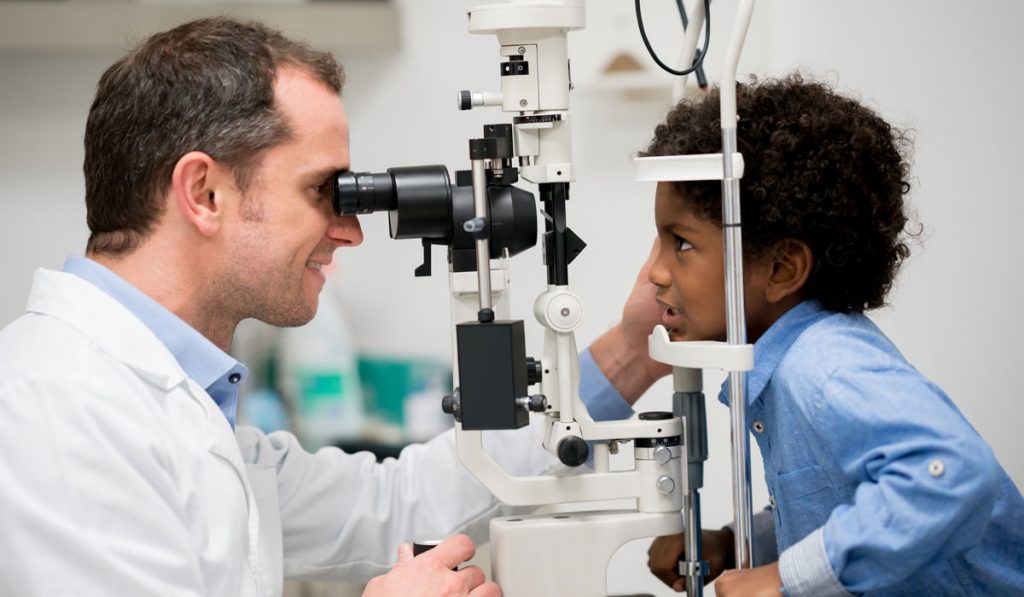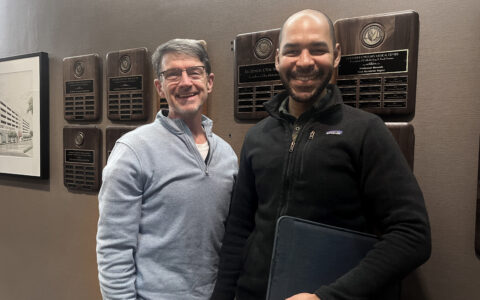About 1 percent of children are affected by intermittent exotropia, where one or either eye wanders. Intermittent exotropia can cause reduced depth perception which may continue well into adulthood. A pilot study, now launching through the Pediatric Eye Disease Investigator Group (PEDIG), will test the use of small prisms embedded in eyeglasses for controlling the amount of time one of the eyes wanders outward in intermittent exotropia.
“In the past, there were three standard ways of treating intermittent exotropia: increased strength eyeglasses, patch therapy, and surgery,” said David Morrison, M.D., associate professor of ophthalmology at Vanderbilt University Medical Center and national co-lead investigator for the study. “We’d like to have some other options. This study will investigate partial prism eyeglasses to find out whether they improve control of the eye wandering.”
Novel Use for Prism Therapy
In exotropia, when one eye drifts the brain begins to ignore the drifting eye to prevent the patient from experiencing double vision. Children may tend to turn one eye off when they can no longer control the drifting. With prism therapy, the prism optically offsets the image so the child may not have to struggle so intensely to hold the eyes straight and may decrease the amount of time an eye drifts.
“Partial correction prisms result in glasses that are much thinner… and they lessen the demand for the person to control the deviation.”
“The end goal is to decrease the amount of time the brain must fight to use the eyes together,” Morrison said. “Prism therapy hasn’t classically been used for this—only in a couple of studies of full prism strength. However, the glasses for full prism correction could be Coke-bottle thick or cause visual aberrations. Partial correction prisms result in glasses that are much thinner than full-prism correction glasses and they lessen the demand for the person to control the deviation, hopefully without the problems of full-strength prisms.”
In the pilot exotropia study, children will be randomized 1:1 between prism glasses and non-prism glasses. Initial outcomes will be judged after an 8-week period to see if control of the eyes is improved and to judge compliance in wearing the glasses. If the pilot is successful, investigators will move forward with a larger, randomized trial. The pilot will be conducted in about 30 sites across the PEDIG network.
Finding New Treatments for Pediatric Eye Disease
Vanderbilt Eye Institute’s (VEI) pediatric ophthalmology team, under the leadership of Sean Donahue, M.D., Coleman Professor and vice president of clinical affairs at VEI, has participated in PEDIG since its inception in 1997. Morrison was recently named vice chair of the group and serves on both the operations and executive committees. In addition to helping lead the prism for intermittent exotropia study, Morrison is involved in evaluating ideas for studies, new study development, quality control, and protocol planning committees.
Donahue was National Protocol Chair for the first PEDIG randomized trial for strabismus surgery, which evaluated which surgical approach was best for intermittent exotropia. The study compared surgery on one muscle on each eye, with surgery on two muscles on one eye. Lori Ann Kehler, O.D., division chief of optometry at VEI, is lead investigator for the VEI site in the first National Eye Institute-sponsored study of low-dose atropine for myopia treatment. Other new PEDIG studies in which VEI plans to participate include refractive surgery to correct amblyopia due to high anisometropia and a study measuring compliance in amblyopia patch therapy using a heat sensor that resides beneath the patch.
“The PEDIG group has studied many conditions across the spectrum of pediatric eye disease or strabismus,” said Morrison. “We are collaborating with the top researchers internationally and developing treatments for many childhood eye diseases. It has been a very exciting group to be a part of.”




